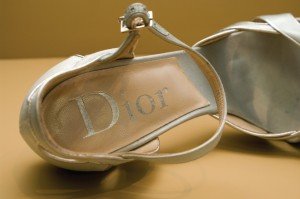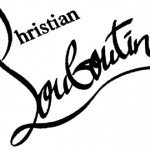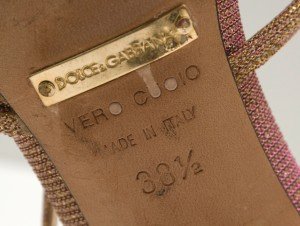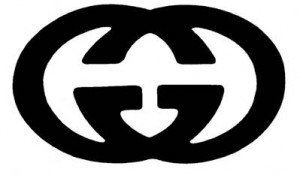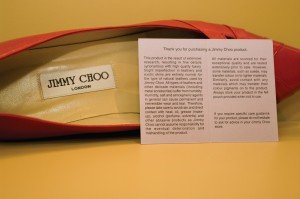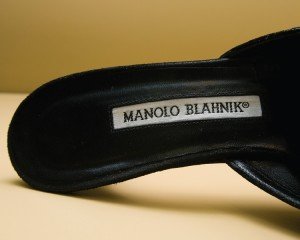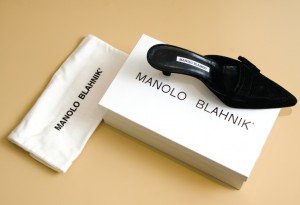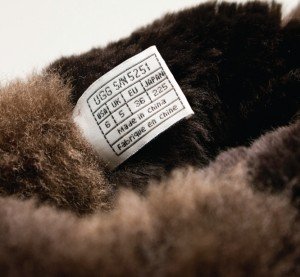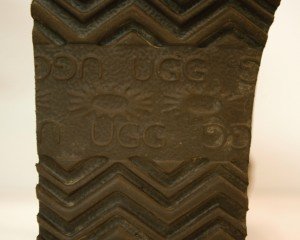With the explosion of online marketplaces, counterfeit shoes have become more unavoidable than ever! Shoppers are continuously looking for designer shoes such as a pair of great Sebago shoes for an affordable price. It takes shopping smarts to get a great deal on a pair of designer shoes and avoid sellers trying to cheat you out of an authentic product.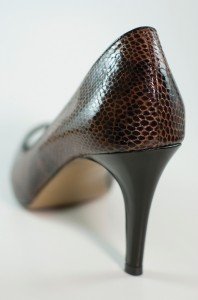
In this chapter, you will discover how to:
- spot warning signs in sellers’ online profiles
- protect yourself from counterfeit scams
- look for hallmarks of authenticity in various designer products
And much more! It is possible to find great deals and great designer shoes online, as long as you shop with caution.
- How to Find Authentic Designer Shoes Online
- Common (and Fake!) Excuses Vendors Use to Explain Why Designer Shoes Have No Labels
- A Closer Look: Designer Shoes Made in China
- A Consequence of Outsourcing: The Counterfeit Market
- Verification of Authenticity
- Chanel
- Christian Dior
- Christian Louboutin
- Dolce & Gabbana
- Gucci
- Jimmy Choo
- Manolo Blahnik
- Nike Air Jordans
- Prada
- Timberland
- UGG®
- Final Word
Fun Facts About Designer Brands
| Back to top | Back to Table of Contents |
How to Find Authentic Designer Shoes Online
$$$ Price
Like it or not, designer shoes are expensive. Sorry to dash your hopes, but if a shoe that usually costs 400 dollars is offered for a mere 89.99, the deal is probably too good to be true. The same goes for those “70% off!” sales. React to low prices with skepticism. It is possible to find relatively affordable second-hand designer shoes, but you should vet these vendors just as thoroughly as you would a discount Internet site. Ask the second-hand vendor for the original paper tags and shoe box. If they no longer have these items, carefully check the shoes’ labels.
Designer shoes are expensive for a reason! The quality of the shoes should be top notch, and a respectable vendor will take complaints regarding the shoes’ quality very seriously. Be suspicious of traces of glue. (Authentic designer shoes are generally stitched together.) Inspect the shoe’s stitching, its heel, and its insole. Pay close attention to the shoe’s label. The label should be well-aligned and precisely stitched to the shoe.
Most Web sites or vendors that sell authentic designer shoes will focus on this niche market. It is a bad sign when you see a Web site offering shoes as well as perfume and kitchen appliances. Or if you see a seller whose merchandise ranges from $5.99 Kmart brand jellies to $500 Gucci pumps.
Carefully examine a seller’s feedback. If there are complaints regarding service or quality of product, stay away. Occasionally vendors of counterfeit goods will be exposed by an unhappy customer. But be careful! The best counterfeit sellers have excellent feedback, because they are able to successfully fool their customers even after the fake shoes have arrived.
Here is another common trick: Some vendors of counterfeit goods build up positive feedback ratings by selling a lot of little items before launching their big scams.
In conclusion, a seller’s feedback rating is a great place to start, but it will not definitively indicate whether or not you can trust the seller.
Most counterfeit shoes are manufactured in Asia, so it is no surprise that many counterfeit vendors have to ship their merchandise from this part of the world. However, these vendors often try to disguise this fact. If a vendor claims to be based in Europe or the United States but attempts to charge you 50 dollars for shipping, it may be a red flag that the shoes are actually coming from somewhere farther afield.
Do not purchase shoes online or through a secondhand market that has a “No Returns” policy. You should be able to return the shoes if you inspect them at home and are not satisfied with the product.
| Back to top | Back to Table of Contents |
Common (and Fake!) Excuses Vendors Use to Explain Why Designer Shoes Have No Labels
Authentic designer shoes should come with labels and paper tags. Here are some common, and most likely fake excuses that vendors of counterfeit shoes may use to convince potential buyers that the shoes are real despite the absence of tags or labels.
Vendor: The shoes don’t have labels or tags because they come directly from the manufacturer.
➡ Think Fast: Designer shoes are not sold directly from the manufacturer, especially not at discount prices or in small quantities. (Different rules may apply if you were, for example, purchasing 100 pairs of Gucci pumps.)
Vendor: We remove the labels before shipping.
➡ Think Fast: Why would a vendor of designer shoes ever do this? These shoes are valuable because people want to show off that coveted designer label. Cutting off the label on a Gucci pump is like blotting out Da Vinci’s signature on the Mona Lisa. There is no innocent explanation.
Vendor: We remove the labels on secondhand merchandise.
➡ Think Fast: It is true that labels are often altered when designer shoes are sold secondhand, but they should not be removed. The standard practice is either to cut the label, or draw a black line through it.
Vendor: The shoes do not come with labels or tags because they are
a sample pair.
➡ Think Fast: This excuse covers the vendor’s tail on two ends. First, he explains that there are no tags because the shoe is a sample, and second, he creates a way to account for any minor differences you might notice between the “sample” shoe and the designer item sold through the regular marketplace. If a vendor were able to get his hands on a sample designer shoe, there would be some kind of “sample” label.
| Back to top | Back to Table of Contents |
A Closer Look: Designer Shoes Made in China
The fact that “American” or “European” shoes are made in China is no secret.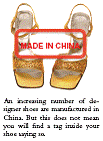 One of the most effective ways to cut costs is to move the base of operation overseas, and China provides an appealing environment in which to set up shop. One in three Nike sneakers
One of the most effective ways to cut costs is to move the base of operation overseas, and China provides an appealing environment in which to set up shop. One in three Nike sneakers comes with a “Made in China” sticker. But this kind of candidness is more complicated for designer brands such as Chanel, Prada, and Armani that have built their companies on the cornerstone of European craftsmanship. Customers spend extra money on a designer shoe because they want a product crafted by an artisan who knows and loves the art of shoemaking, not by a factory worker in China.
So how do these name brands get away with labeling their shoes as “Made in Italy” when they are actually “Made in China”? The brands benefit from very flexible labeling laws that base a product’s label on the final point of production. For example, a shoe may be mostly manufactured in China but have its leather sole attached in Italy. And voila! The shoe is legally “Made in Italy”.
That is not to say that designer shoes now manufactured in China are of a lesser quality than designer shoes previously manufactured in Europe. The claim is that shoemakers in China are fast and precise. They still produce quality shoes—just in less time and for less money.
| Back to top | Back to Table of Contents |
A Consequence of Outsourcing: The Counterfeit Market
Stopping the sale and production of counterfeit shoes is more complicated than ever. This is partly because it is becoming more difficult for a consumer to tell a fake from an authentic shoe. And with good reason!
Most European and American shoe companies manufacture their products overseas. By outsourcing the production of their footwear to factories in Asia, these companies give up some control over the design knowledge that makes an Armani or Prada or even Nike shoe special in the first place. The result is the emergence of the “third shift,” also known as the “ghost shift” or “midnight shift.” Factories that are licensed by a company to produce brand-name sneakers make shoes for that company during the day; then at night, these same factories produce an extra thousand pairs of shoes to be sold on the black market as counterfeits. These “third shift” shoes may be made out of cheaper materials, but they are made on the same equipment and sometimes by the same people. As a result, the counterfeits are extremely difficult to distinguish from an authorized version of the shoe.
This kind of problem is one of the risks that major shoe companies take when they decide to manufacture their products overseas. However, the companies are saving enough money by outsourcing that it is well worth the risk.
| Back to top | Back to Table of Contents |
The counterfeit market will continue to thrive as long as there are buyers eager to purchase counterfeit goods. Most people who buy counterfeit items in person know that they are purchasing an inauthentic product. They enjoy the appearance of owning luxury items without having to pay luxury prices. For this reason, many counterfeit manufacturers do not bother to match their merchandise exactly to the authentic product. Shoes, shoe boxes, and dust bags that are identical to the designer version are not necessary when your buyer knows that he or she is purchasing a fake.
The retail of counterfeit shoes online has brought a whole other dimension to the counterfeit marketplace. Suddenly vendors are able to dupe unsuspecting buyers who think they are getting an incredible online deal. Photos of authentic designer items are used to advertise fakes, and often the buyer does not realize the mistake until the shoes have arrived in the mail.
Shopping Online
Shopping for designer items online requires shopping smarts. The following pages provide you with checklists and general guidelines for some of the most commonly counterfeited brands and shoes including Chanel Cambon ballerina flats, Nike Air Jordans, and UGG® boots
. These checklists are designed to help get you started. Do not be afraid to ask online vendors additional detailed questions about their products. It is perfectly acceptable to ask sellers on eBay and other online marketplaces to send detailed pictures of the shoe’s label, sole, and other crucial areas. Honest vendors should be happy to verify the authenticity of their merchandise.
Important Notice Regarding the Following Information
Most vendors of designer merchandise refuse to answer questions regarding authenticity because they do no want to provide counterfeiters with information that potentially could help them produce even more convincing counterfeit products. Consequently, it is difficult to obtain definitive information regarding current logos, labels, and packaging information.
In addition, designer logos, labels, and packaging are constantly changing and are not necessarily consistent from season to season or between different styles of footwear.
As a result, we would like to stress that the following pages are not meant to be the final word on what passes as authentic and what does not. The designer companies themselves are the only definitive authority on their merchandise and trademarks. Instead, use this guide as a handy helper. The photographs are examples only. Your authentic product may not match them exactly. The checklists and guidelines are based on authentic products that we have inspected, but they do not account for every authentic designer product out there.
| Back to top | Back to Table of Contents |
Cambon Ballerina Flats
Counterfeit versions of Chanel’s Cambon ballerina flats have flooded the online market. Extra caution is required when shopping online for this particular style of Chanel shoe.
Inside the Shoe:
❑ Does the label inside the shoe read “CHANEL”? Note: If you see a Cambon ballerina flat labeled “CC,” it is a fake. Also, there should be no extraneous lettering on the labels such as “Made in Italy” or “Made in France.”
❑ If the flats are white, pink, or tan, is the label black?
❑ If the flats are black, is the label white?
The Sole of the Shoe:
❑ Is the heel made of plastic?
❑ Is the heel stamped with “CHANEL” and “Made in Italy?” Note: If the heel is stamped with “CC,” the shoe is a fake.
❑ Is the word “CHANEL” printed in big, bold lettering underneath the plastic? Note: This lettering must be printed underneath the plastic. It should not be part of the plastic or printed on top of the plastic.
❑ Is the word “CHANEL” written in big, bold lettering?
❑ If the flats are black or white, is the “CHANEL” label hot pink?
❑ If the flats are tan or pink, is the “CHANEL” label black?
❑ If the flats are special edition flats (i.e., white with the python design or silver), is the “CHANEL” label orange?
The Packaging of the Shoe:
❑ Is the shoe box black?
❑ Is the word “CHANEL” written in capital letters across the top of the box? Is the lettering parallel to the box’s longer side?
❑ Is the dust bag black with white “CHANEL” lettering?
Note: Genuine Chanel Cambon Ballerina Flats do not come with a statement of authenticity. Yours shouldn’t either!
 Here is an example of an authentic Chanel shoe box and dust bag. Note how the brand name “CHANEL” is written in capital letters parallel to the long side of the box. Pay attention to the particular font used by the Chanel brand, and how the lettering on the box matches the lettering on the dust bag.
Here is an example of an authentic Chanel shoe box and dust bag. Note how the brand name “CHANEL” is written in capital letters parallel to the long side of the box. Pay attention to the particular font used by the Chanel brand, and how the lettering on the box matches the lettering on the dust bag.
This Chanel high heel is in no way a doppelganger for the Chanel Cambon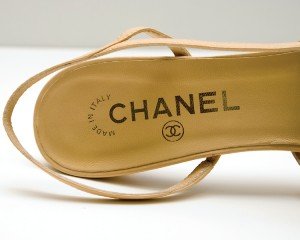 Ballerina flats. (You will note the presence of the “CC” logo and the description “Made in Italy”—both details conspicuously absent on the flats.) However, you can still glean a sense of what an authentic Chanel logo looks like when printed on the insole of a shoe.
Ballerina flats. (You will note the presence of the “CC” logo and the description “Made in Italy”—both details conspicuously absent on the flats.) However, you can still glean a sense of what an authentic Chanel logo looks like when printed on the insole of a shoe.
| Back to top | Back to Table of Contents |
If you are shopping for Dior shoes, you are likely to find a label on the shoe’s insole that depicts an ornate shield shape surrounding the words “Christian Dior.” The words “Christian Dior” are perpendicular to the length of the shoe, with the word “Christian” toward the heel above the word “Dior”toward the toe.
This label differs from an alternate, and most likely older, Dior logo, which you can see in the photograph above. This logo depicts a large “Dior” with an uppercase “D” and lowercase “ior.” Notice how “Dior is written along the length of the shoe, with the D at the heel and “r” toward the toe.
The Sole of the Shoe:
Shoes with the “Dior” label, as opposed to the ornate shield design, should have the same “Dior” stamped onto the sole of the shoe. The words “MADE IN ITALY” should also be stamped on the sole.

The Shoe’s Packaging:
The photograph above is an example of an authentic Dior shoe box and dust bag. This particular box depicts the “Dior” label, as opposed to the ornate shield design. Note that the word “Dior” on the box runs parallel to the shorter side of the box.
Note: Dior shoes do not come with authenticity cards!
| Back to top | Back to Table of Contents |
Christian Louboutin
❑ Does the “Christian Louboutin” trademark have “hristian” in block letters, “Louboutin” in cursive script, and the “L” in “Louboutin also serving as the “C” in “Christian”?
❑ Is the “Christian Louboutin” trademark located in the heel area of the insole?
❑ Is the word “Louboutin” significantly largely than  the word “Christian”?
the word “Christian”?
❑ Is “Paris” printed on the insole? It should be printed in the midfoot
area (near the arch) and centered.
The Sole of the Shoe:
❑ Is the sole of the shoe the distinctive Louboutin red?
❑ Is the “Christian Louboutin” trademark described above stamped onto the sole? (Note: The brand name should be identical to the brand printed on the insole.)
❑ Are the words “MADE IN ITALY” printed above the shoe’s size?
❑ If you hold the shoe toe up, is the brand name upside down?
The Shoe’s Packaging:
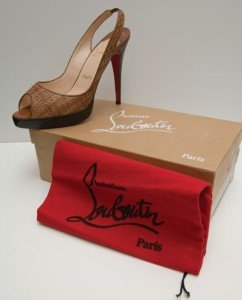 ❑ Is the dust bag the same red as the shoes’ soles?
❑ Is the dust bag the same red as the shoes’ soles?
❑ Does the brand name on the dust bag match the brand name on the shoe box?
| Back to top | Back to Table of Contents |
Inside the Shoe:
❑ Is the brand name “DOLCE & GABBANA®” printed on the insole of the shoe? (Note: The brand name should be written in capital letters and an ampersand should always be used—never the word “and.”)
❑ Is the brand name written along the length of the shoe? The “D” should be at the heel and the final “A” should be toward the toe.
❑ Is the ampersand (&) smaller than the letters in the words “DOLCE” and “GABBANA®”?
❑ Is “MADE IN ITALY” printed underneath the brand name?
❑ Is there a registered trademark (®) just above the last “A” in “GABBANA®”?
The Sole of the Shoe:
Depending on the style of shoe, the “DOLCE & GABBANA®” brand name can either be engraved onto the bottom of the sole or engraved onto a metal plate, which is screwed to the bottom of the sole. In either case, be sure to check the lettering’s font, size, and spelling.
Notice how even when the brand name is engraved on the metal plate, it retains its salient characteristics: capital letters, small ampersand, and a distinctive font.
| Back to top | Back to Table of Contents |
Inside the Shoe:
❑ Does your Gucci shoe have an eight-digit serial number? This number should be printed inside the shoe on the shoe’s lining next to the shoe size.
❑ Does your Gucci shoe have the word “GUCCI” stamped inside the shoe near the heel?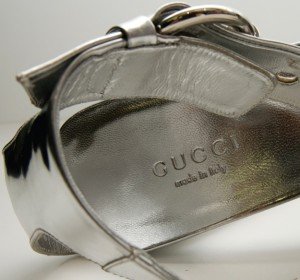
❑ Is there a smaller stamp that says “made in Italy” printed below the brand name?
The Sole of the Shoe:
❑ Does your Gucci shoe have the words “GUCCI” and “made in Italy” stamped on the sole of the shoe? (Note: Sometimes men’s shoes have the brand name engraved on a silver plate.)
❑ Is the sole well made? Is it made from the correct materials? (Tip: Look up your shoe on the official Gucci Web site to identify the correct material of the sole. Most Gucci dress shoes will be made with leather soles. Athletic shoes as well as some flats and heels are made with rubber soles.)
The Shoe’s Packaging:
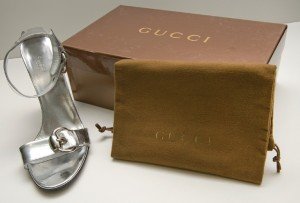 This picture is an example of an authentic Gucci shoe box and dust bag. Boxes and bags can come in a variety of colors. The Gucci lettering is often metallic. Do not worry if your box and bag differ from the picture at the right. What is most important is that the lettering on the box and bag match the distinctive Gucci logo.
This picture is an example of an authentic Gucci shoe box and dust bag. Boxes and bags can come in a variety of colors. The Gucci lettering is often metallic. Do not worry if your box and bag differ from the picture at the right. What is most important is that the lettering on the box and bag match the distinctive Gucci logo.
| Back to top | Back to Table of Contents |
Inside the Shoe:
❑ Is there a neat row of stitching on the top and bottom sides of the label? (Note: If the label is simply inserted into a slit in the insole with no stitching, the shoe is most likely a fake.)
❍ Does the label say “JIMMY CHOO”?
❍ Is the lettering uppercase?
❍ Is the font correct?
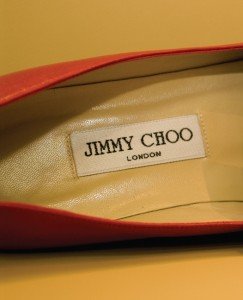
❍ Is the “OO” in Choo upright?
(Note: If the “OO” is italicized, the shoe is most likely a fake.)
❍ Is the city name “LONDON” printed in a smaller size below the brand name?
The Sole of the Shoe:
❑ Is the brand name “JIMMY CHOO” stamped on the sole?
❑ Is the city name “London” stamped in smaller lettering beneath the brand name?
❑ Is “MADE IN ITALY” stamped right above the shoe’s size?
❑ Some Jimmy Choo shoes with leather soles have the words “VERO CUOIO” (Italian for “real leather”) stamped on the soles of the shoe. If this is true of your shoes, are the words “VERO CUOIO” located inside a shield? Do they take up almost all of the space inside the shield?
The Shoe’s Packaging:
This photo is an example of an authentic Jimmy Choo shoe box and
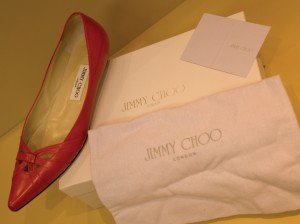 dust bag. Notice how the color of the shoe box and dust bag match, and how the text is oriented the same way on both box and bag (i.e., parallel to the longer side). Do not be alarmed if your box and bag differ from this photo. What is most important is the integrity
dust bag. Notice how the color of the shoe box and dust bag match, and how the text is oriented the same way on both box and bag (i.e., parallel to the longer side). Do not be alarmed if your box and bag differ from this photo. What is most important is the integrity
and consistency of the “JIMMY CHOO” logo.
Refer to the authentic Jimmy Choo shoe below. You can even read the care card that comes with new Jimmy Choo shoes.
A final word on Jimmy Choo Couture:
Changing Times in the Designer World
Believe it or not, Jimmy Choo shoes are no longer designed by Jimmy Choo! The designer sold his share of the company in 2001. If you want a pair of shoes designed by Jimmy Choo himself, you will have to visit Paddington in London, England and shop for Jimmy Choo Couture.
| Back to top | Back to Table of Contents |
Inside the Shoe:
❑ Does your Manolo Blahnik have a label stitched to the insole?
❑ Is the label well aligned?
❑ Is it stitched on all four sides?
❑ Is the brand name spelled correctly? Is it printed in capital letters?
(Note: Shoes from the “My Favorites” collection may sport a label with Mr. Blahnik’s signature.)
The Sole of the Shoe:
❑ Is the sole of the shoe leather?
❑ Is the shoe box white with black lettering?
❑ Is “MANOLO BLAHNIK” spelled correctly? Is it in the correct font?
❑ Is the dust bag white with black lettering?
Tip
Unlike other shoe brands, Manolo Blahnik shoes do not have embossed serial numbers. If you see an embossed serial number on any part of the shoe, then the shoe is probably a fake.
| Back to top | Back to Table of Contents |
Owning a pair of Air Jordans has long been a symbol of social status. The shoes are expensive, which means that people will go to great lengths to own a pair. It also means that there is an army of counterfeit sellers who specialize in Air Jordans
.
❑ Is the basketball on the right side of the logo (i.e., your right)?
❑ Is the jumping Jordan placed between the “R” and “D” of the word “Jordan”?
❑ Does the arm with the ball veer to the right of the logo?
The Shoe’s Packaging:
❑ Does the production number of the shoes’ tag match the production number printed on the box?
❑ Are the shoes wrapped in brown paper? (Not tissue paper.)
Note: The best advice for spotting a counterfeit Air Jordan is to do your research ahead of time. Nike has released many versions of this shoe and each version is unique. Find a photo of the shoes online at Nike’s Web site and compare your shoes to it. Color, material, details like stripes or the placement of the Nike “swoosh” should all be examined carefully. A key feature to examine is the color of the shoe’s sole. Several manufacturers of fake Air Jordans neglect this area of the shoe.
| Back to top | Back to Table of Contents |
Prada
❑ Does the label or stamp read “PRADA” with “Made in Italy” printed in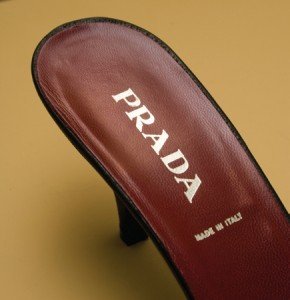 smaller text?
smaller text?
❑ Is the word “PRADA” in all caps? Is it written in the correct font?
❑ If the shoe is a sports shoe, does it have a removable insole?
❍ Is there an additional “PRADA” logo beneath the removable insole?
❍ Is the second logo located in the heel area?
The Shoe’s Packaging:
Please note that the following information is only applicable to Prada sports shoes.
❑ Is the logo located on the side of the box (i.e., not the top)?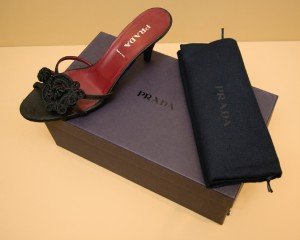
❑ Is the brand name accompanied by information about the size, price, and model of the shoes?
❑ Do the shoes come with a silver sleeper bag?
❑ Is the logo on the bag red? Is the drawstring of the bag silver? Here is an example of a genuine Prada shoe box and dust bag for a woman’s dress shoe. Do not be alarmed if your box and bag differ from the one pictured.
Additional Features:
Prada sports shoes often have an embossed upside-down triangle (the  traditional Prada logo). This triangle is often attached to the shoe’s tongue or the back of the heel.
traditional Prada logo). This triangle is often attached to the shoe’s tongue or the back of the heel.
If your Prada shoes come with the triangle logo, verify that it has the following features:
❑ Does the logo read “Prada” on the top line?
❑ Are the words “MILANO” and “DAL 1913” printed below the brand name? Tip: Double-check the spelling of these words as well as the date. (It is 1913 not 1931!)
❑ Is the date written on what looks like a scroll or ribbon?
❑ Is a coat of arms depicted below the date?
| Back to top | Back to Table of Contents |
❑ Is there a style number inside the shoe? It should either be listed under the tongue or along the inside of the upper. It is usually listed next to the shoe’s size.
❑ Is the style number five digits long?
❑ Note: The number 10061 is the style number of the classic Yellow Timberland boot. If you see this style number on any shoe other than the classic Timberland, you are probably looking at a fake.
❑ Is the shoe size listed inside the shoe an American size? All Timberlands come in American sizes. They can either be listed as “W” for wide or “M” for medium.
The Shoe’s Tags:
❑ Is there a paper tag attached to the shoe’s eyelets?
Note: The tag should not have a barcode on it. It should also not say “Genuine Timberland” or be made out of cardboard.
The Shoe’s Packaging:
❑ Is the style number listed on the shoe box? Does it match the style number listed inside the shoe?
Note: Always be sure to check that the Timberland style you purchase online matches a style that can be found on the official Timberland Web site. Many Timberland counterfeits have no corresponding authentic Timberland style.
| Back to top | Back to Table of Contents |
The maker of UGG® boots is unusual among shoe makers in providing information on how to avoid counterfeit products and actively encouraging its customers to fight counterfeiting. A quick visit to the counterfeit education section of the Web site www.uggaustralia.com could save you from wasting your money on a fake pair of UGG®
boots.
Inside the Shoe:
❑ Does the label inside the boot read “Made in China”? (Note: Genuine UGG® boots are made in China by an American company called Deckers
Inc. A “Made in New Zealand” label is actually a bad sign. The only exceptions are UGG® Nightfall, UGG® Sundance boots, and UGG® Ultra boots
.)
❑ Is the label white? All genuine Decker’s UGG® boots have white labels, never blue.
❑ Is there a registered trademark symbol (®) on the sole of the shoe? Fake UGG® boots usually have the brand name without the registered trademark symbol.
Additional Features:
❑ Do the boots feel like they are made from real sheepskin?
❑ Tip: If you rub synthetic wool, the hair will come out easily and start to disintegrate. Synthetic hair is also not as soft as real sheepskin.
❑ Do the boots smell like they are made from real sheepskin? Do not be afraid to use your nose to sniff out a fake! Be suspicious of any scent of glue or chemicals.
❑ Do your UGG® boots come with a cream-colored card describing how to care for your UGG® boots? These cream-colored cards replaced
Care booklets shipped with UGG® boots made prior to June 2007.
Note: All “camel-colored” UGG® boots are fakes. Deckers Inc. does not make UGG® boots in that color.
| Back to top | Back to Table of Contents |
Final Word
One of the best ways to spot counterfeits is to look for quality workmanship. Authentic designer shoes are made from the finest materials. Stitching and label attachment should be immaculate. Seams should be smooth with no traces of glue, cut-away leather, or unsightly wrinkles.
If a particular designer brand is not listed in the pages above, you can visit  the Web sites www.portero.com or www.net-a-porter.com. Both of these sites sell authenticated designer items. Even better, they include excellent pictures of designer shoes taken from various angles. You can zoom into these pictures to examine shoe details.
the Web sites www.portero.com or www.net-a-porter.com. Both of these sites sell authenticated designer items. Even better, they include excellent pictures of designer shoes taken from various angles. You can zoom into these pictures to examine shoe details.
In addition to www.portero.com and www.net-a-porter.com, designer
shoes can be securely purchased from Saks Fifth Avenue, Barneys New York, Neiman Marcus, and Bergdorf Goodman.
| Back to top | Back to Table of Contents |
Fun Facts About Designer Brands
Armani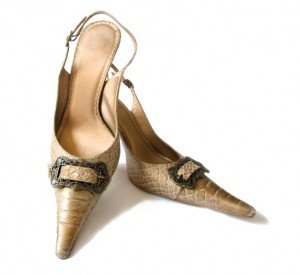
• The first Armani hotel is located on the first 34 floors of the Burj Khalifa, formerly known as the Burj Dubai, the tallest building in the world. Armani hotels have been planned for Milan, London, and New York.
• Armani was the first designer to ban models with a body mass index under 18 (equivalent to a size zero) after Uruguayan model Luisel Ramos dropped dead from heart failure related to anorexia.
Chanel
• Coco Chanel was friends with Picasso and Stravinsky. She had an affair with the Duke of Westminster (among other influential men), but when asked why she never married, Chanel famously replied: “There have been several Duchesses of Westminster. There is only one Chanel.” (Note 8)
• Two biopics about Coco Chanel were released in 2009: Coco avant Chanel and Coco Chanel & Igor Stravinsky. Neither film mentions that Chanel collaborated with the Nazis during World War II.
Christian Dior
• Christian Dior’s family made its fortune manufacturing fertilizer. Dior attended the École des Sciences Politiques to satisfy his parents’ hopes that he would become a diplomat.
• As a young man, Dior sold sketches on the street for roughly 10 cents each.
Christian Louboutin
• Starting at age 12, Christian Louboutin used to sneak out of school to watch showgirls in Paris nightclubs. Showgirls were the inspiration behind his decision to become a shoe designer: “They influenced me a lot. If you like high heels, it’s really the ultimate high heel—it’s all about the legs, how they carry themselves, the embellishment of the body. They are the ultimate icons.” (Note 9)
• Louboutin has never owned a television and admits that he is “not very ambitious.” (Note 10)
• The 1987 German movie “Wings of Desire” inspired Louboutin to learn to swing on a trapeze; he installed a trapeze in his studio.
Gucci
• Despite mythology about the Gucci family’s having been saddle makers to wealthy Florentine families, Guccio Gucci left Italy to work as a dishwasher at the London Savoy after his father’s hatmaking business went under. He worked his way up to being a waiter while observing the habits of London’s wealthiest citizens. Seeing their obsession with fancy leather luggage, Gucci eventually returned to Italy and learned the art of leatherwork.
• The compact AMC Hornet Sportabout station wagons were offered in Gucci models in 1972 and 1973.
Jimmy Choo
• Jimmy Choo was born in Malaysia to a family of shoemakers. He reportedly made his first pair of shoes when he was 11 years old.
• Jimmy Choo paid his way through the Cordwainers Technical College in London Borough (now part of the London College of Fashion) by working in restaurants and cleaning a shoe factory.
Prada
• Founder Mario Prada did not allow women to enter his leather goods business. Nevertheless, his granddaughter Miuccia Prada—who has a Ph.D. in political science and was a member of the Communist party—inherited the company from her mother in 1978 and greatly expanded upon its success.
Manolo Blahnik
• Manolo Blahnik grew up on a banana plantation in the Canary Islands.
• Manolo Blahnik shoes are referenced in several popular TV shows. They are a favorite of Carrie Bradshaw on Sex and the City and worn by Karen Walker on Will and Grace.
Nike
• The Nike “swoosh” was designed by Carolyn Davidson, a student at University of Portland. She was paid 35 dollars for her work by Phil Knight, the founder and chairman of Nike. Knight made it up to Davidson in 1983 when he presented Davidson with stock in the company and a “swoosh” diamond ring.
• The Nike “swoosh” was designed to represent the wings of the Greek goddess Nike, the goddess of victory. Historically, the goddess Nike was invoked on the battlefield. She was a symbol of athletic strength, speed, and glory. But Nike was portrayed with wings not because she could fly as high as Michael Jordan or move as fast as Michael Johnson; the wings served as a reminder that victory is fleeting—a very un-Nike-like sentiment!
Timberland
• The Grammy Award-winning rapper, singer, and record-producer Timbaland adopted his stage name after Timberland boots became popular in hip-hop culture. His given name is Timothy Zachery Mosley.
• In the song, “Can I Get A…” Jay-Z references Timberland boots when he raps: “Cause from now on you can witness Jay the I-con! With hoodies and Timbs on.”
UGG®
• Ugg is alleged to be a generic term used in Australia and New Zealand since at least the 1970s to describe sheepskin boots. The word has been the subject of an extended trademark dispute.
Versace
• The late Princess Diana was offered one million British pounds (about $1.5 million in 1996) to walk down the runway in Versace to celebrate her divorce from Prince Charles. She declined the offer.
• Gianni Versace was murdered outside his Miami home by a rampage killer. Versace was 50 years old.
Note 8: “High Priestess of High Fashion: GABRIELLE CHANEL” Time, August 22, 1960 (visited March 4, 2010); www.time.com/time/magazine/article/0,9171,869848,00.html.
Note 9: Nina Jones, “Christian Louboutin: the sole man,” The Telegraph, August 10, 2008 (visited March 4, 2010); www.telegraph.co.uk/fashion/3365106/Christian-Louboutin-the-sole-man.html.
Note 10: Id.
| Back to top | Back to Table of Contents |
Go to CHAPTER 7 – How to Care for Shoes


